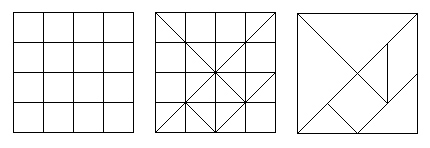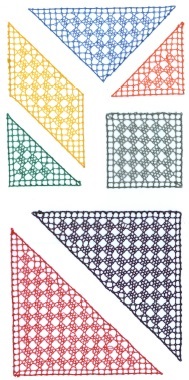What is Tangram?
Tangram is one of the most popular games to lay.
You can create figures from seven stones, namely five
triangles, one square and one parallelogram. All the stones must be used.
They must touch but not overlap.
Main Problem top
| All seven tangram pieces consist of half squares with
this shape: |
 ....................................................................................................................................... ....................................................................................................................................... |
There are 32 half squares or 16 squares altogether.
... ... ... |
You can build a 4x4-square with all the 16 squares. The
main problem of the 'tangram research' is building a square with all the
7 pieces. |
Comments:
You can also choose the smallest tangram piece, the blue
triangle, as the basic triangle. I took the half triangle as the basic
form, because the square built of all seven tangram pieces has the simple
length 4.
| Basic triangle on this page: |
 ............................... ............................... |
Another way: |
 ................ ................ |
The difference is: You have to change the rational und irrational
length of a side.
Building Figures
1st problem: New figures top
... ... ...
|
You can invent new figures.
A figure is good, if you recognize it by seeing.

There are thousands of figures, which people have already
built. |
... ... ...
|
[3sqrt(2)]x[3sqrt(2)]-squares are possible, if you leave
blank one triangle or two.
 |
2nd problem: Filling given shapes
top
...... ..... ..... |
You must find the right position of the tangram pieces
filling this shape. (Solution in the end of this chapter) |
3rd problem: How many possibilities
are there to lay the same figure? top
... ... ...
|
You can lay the trapezium in two different ways.
 |
Paradoxes
... ... ...
|
This trapezium is not a solution. If you lay this figure,
you find the mistake:
The yellow and the green piece are a little bit bigger.
You use the fact, that 4 and the triple of the square
root of 2 (=4.24) are about the same. |
 |
Other paradoxes comparing two similar tangram figures,
which seem to be alike.
An example by H.Dudeney
|
Solution:
 |

Tangram Birds top
About 100 students (aged 11/12/13) got the task to design
birds by tangram pieces.
Here is a small selection of nice birds.

Not all the students became friends with tangram pieces:
 [= I
hate tangrams ;-).]
(Thanks to 6b, 6c, 7a, 7c, 7d in 1999/2000) [= I
hate tangrams ;-).]
(Thanks to 6b, 6c, 7a, 7c, 7d in 1999/2000)
Paul's
Men
My grandson Paul (11) sent me the following figures for
this page.
Classifying Figures
top
You can follow the positions of the sides of the half
squares.
1 the sides at the right angle
are horizontal or vertical
2 the side opposite the
right angle is horizontal or vertical
3 mixture of 1 and 2
4 any position
If you have a mathematical point of view, you must allow
only 1 and 2.
Nearly all tangram figures belong to model 4. There are
many nice and expressive forms, because there are less rules. They are
organized by topics.
Convex Figures top
'A figure is convex', means: If you choose any two points
inside the figure, the whole line between the points must also be inside
the figure.
 |
Surprising: There are only 13 convex figures, you can
build from tangram pieces. |
Proof by Fu Traing Wang and Chuan-Chih Hsiung in 1942 (Book
4)
Grid
Tangrams with Convex Perimeter top
 |
You find an interesting suggestion in book 3 and book
4 to classify tangram figures. This only refers to 'mathematical' figures',
which bird 1 and bird 2 (see above) stand for. You can lay them into a
coordinate system, so that the corners of the seven tangram pieces have
integers as coordinates. In other words: You can order the tangram pieces
in a way that the sides with the unit 1 are horizontal or vertical. The
lines with the unit (root of 2) are diagonal. |
The figures are widened by little (white) triangles as necessary,
so that a convex figure develops. These triangles have the same size as
the blue tangram pieces. You count the triangles. Bird 1 needs 14 triangles
and is 14-convex. Bird 2 is 5-convex. The convex figures don't need a triangle.
They are 0-convex. You find all 133 (abstract) 1-convex tangram figures
and solutions in book 4.
There is the problem to find figures
with the largest convex perimeter.
Bruno Curfs found the following seven 41-convex tangrams.
Probably 41 is the upper limit (5).
...
... ... ... |
I received more 41-convex tangrams:
8 from Ludwig Welther, 9 from Hartmut Blessing,
10 and 11 from Hannes Georg Kuchler. |
... ... ... |
Daniel Gronau checked all possible grid tangrams by his
computer. He found out that there are three more solutions. |
Bruno Curfs proved mathematically
that 44-konvex is an upper limit (5).
Making of Tangram
Pieces top
Probably the tangram pieces are developed from cutting
a 4x4-square in pieces.
 You use it to make tangram pieces. You draw a 4x4-square
with some diagonals on plywood or on cardboard. Then you saw or cut the
pieces as shown at the drawing.
You use it to make tangram pieces. You draw a 4x4-square
with some diagonals on plywood or on cardboard. Then you saw or cut the
pieces as shown at the drawing.
ALOIS STUDER MADE BOBBIN LACES OF THE SEVEN TANGRAM PIECES.

|

Angel
|
Now (July 8th) Alois Studer sent me another artistic
work.
It is very interesting, because he formed a square by
two big, three small and two very small tangram sets.
Variants
of the Tangram Game top
 You can make more tangram games, if you divide simple geometric
figures like square, rectangle or circle. The most famous are (1) "Pythagoras",
(2) "Kreuzbecher", (3) "Alle Neune", (4) "Circular Puzzle",
(5) "The Broken Heart", and (6) "The Magic Egg".
You can make more tangram games, if you divide simple geometric
figures like square, rectangle or circle. The most famous are (1) "Pythagoras",
(2) "Kreuzbecher", (3) "Alle Neune", (4) "Circular Puzzle",
(5) "The Broken Heart", and (6) "The Magic Egg".
Here is a wide field for designing your own tangram pieces
and playing with them.
Tangram on the
Internet top
German
Claus Michael Ringel
Tangram
Gerd Müller
Tangram
interaktiv
Herbert Hertramph
Tangram-Spiel
von Jos van Uden, Tangram-Spiel
von Serj Dolgav zum Herunterladen
Michael Bischoff
Tangram for you
stopkidsmagazin
Tangram
online
tan-gram
tangram mit einer
galerie von 75 exponaten
Wikipedia
Tangram
English
Andrew D. Orlov
Tangram
House
Barbara E. Ford
Tangrams - The Magnificent
Seven Piece Puzzle
Gianni A. Sarcone and Marie-Jo Waeber
Tangram,
the incredible timeless 'Chinese' puzzle
Marie-Jo Waeber and Gianni A. Sarcone (Archimedes'
Laboratory)
Tangramagic
Michael Bischoff
Tangram for you
Paul Scott
CONVEX
TANGRAMS
Wikipedia
Tangram
References (German)
top
(1) Pieter van Delft, Jack Botermans: Denkspiele der
Welt, München 1998
(2) Karl-Heinz Koch: ...lege Spiele, Köln 1987 (dumont
taschenbuch1480)
(3) Rüdiger Thiele, Konrad Haase: Teufelsspiele,
Leipzig 1991
(4) Joost Elffers, Michael Schuyt: Tangram, Dumont, Köln
1997
(+ tangram pieces)
(5) Bruno Curfs: Mathematical Tangram, CFF, newsletter
of the "Nederlandse Kubus Club" NKC, 65 (November 2004)
(6) Jerry Slocum, Dieter Gebhardt, Jack Botermans, Monica
Ma, Xiaohe Ma: The Tangram Book, 2003
[ISBN 1-4027-0413-5] Sterling
Publishing Company
Feedback: Email address on my main page
This
page is also available in German.
URL of
my Homepage:
https://www.mathematische-basteleien.de/
©
1999 Jürgen Köller
top |